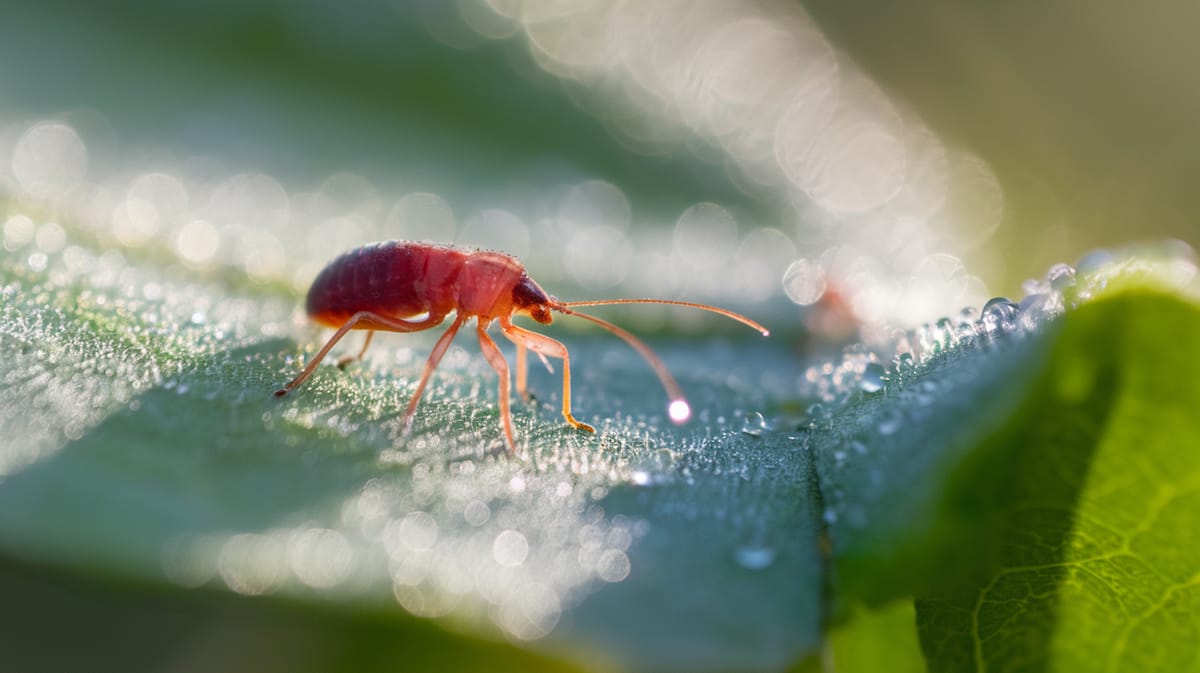Clover Mite
Tiny but mighty, the Clover Mite thrives in numbers, congregating on sunlit surfaces during spring and fall. Known for their vibrant red hue, they play a key role in controlling plant growth.

Key Insights at a Glance
Did You Know?
Taxonomy & Classification
Clover mites are tiny arachnids adapted to thrive in temperate regions, known for their distinctive reddish-brown color and rapid reproduction on host plants. Let's understand the evolutionary journey and classification of these remarkable herbivores.
Global Distribution
Clover mites, primarily found in North America and Europe, thrive in temperate zones, adapting to varied environments across the globe.
Evolutionary Resilience
Originating in the Cretaceous period, clover mites have survived significant climatic changes, showcasing their adaptability and resilience.
Lifecycle and Growth
A remarkable journey of transformation from Egg to Adult.
Egg
Clover mite eggs are laid in protected crevices, where they remain dormant until favorable conditions prompt hatching.
Nymph
Nymphs hatch and feed voraciously on plant sap, undergoing several molts to grow and mature.
Adult
Adults continue feeding on plant sap, reproduce, and lay eggs in secure locations to start the cycle anew.
Dietary Habits
A plant sap-sucker with keen feeding skills, this mite adapts to various plant-based diets for survival and growth.
| DIET TYPE | DESCRIPTION |
|---|---|
| Primary Diet | Feeds primarily on plant sap, extracting nutrients from clover, grasses, and ornamental plants through piercing mouthparts. |
| Secondary Diet | Consumes other plant materials like algae and mold, supplementing its diet when main food sources are scarce. |
| Occasional | Occasionally feeds on pollen or fungi under conditions where typical plant hosts are unavailable. |

Behaviour and Adaptations
Discover the unique adaptations that help the Clover Mite thrive in varied environments.
Quick Reproduction
Rapid reproduction allows them to quickly colonize new areas.
Sun Avoidance
Actively avoid sunlight to prevent desiccation.
Color Camouflage
Red bodies blend well with plant surfaces, avoiding predators.
Ecosystem Impact
Clover mites play a vital role in maintaining environmental balance.
Soil Aeration
Clover mites help loosen soil, improving air and water movement.
Food Source
Serve as an important food source for various predators.
Organic Matter Breakdown
Contribute to the decomposition of organic matter, enriching soil nutrients.
Conservation Challenges
Understanding and addressing the major threats to Clover Mite populations.
Habitat Destruction
Urban development reduces available grassland habitats for Clover Mites.
Chemical Exposure
Pesticides and lawn treatments harm Clover Mite populations.
Climate Change
Altered temperatures and rainfall patterns affect their life cycle and distribution.
Frequently Asked Questions
How long do Clover Mite live?
Clover Mites have a short lifespan, usually living for about one month. They reproduce quickly, often creating multiple generations in a single year, especially during the spring and fall when conditions are favorable.
What do Clover Mite eat?
Clover Mites primarily feed on clover, grass, and other plants. They consume the sap from the leaves, which can cause the foliage to appear silvery or stippled. While they are not harmful to the plants, they can become a nuisance in large numbers.
Are Clover Mite poisonous?
Clover Mites are not poisonous to humans or pets. They do not pose any health risks but can stain surfaces when crushed due to their red coloration, which can be a nuisance in homes.
Are Clover Mite endangered?
Clover Mites are not endangered. They are widespread and commonly found in many regions, particularly in temperate climates. Their ability to reproduce quickly and adapt to various environments contributes to their abundance.
What do Clover Mite symbolize?
Clover Mites do not have any widely recognized symbolic meanings. They are often considered pests due to their tendency to invade homes and gardens in large numbers, especially during certain times of the year.
Do Clover Mite bite?
Clover Mites do not bite humans or pets. They are harmless in terms of physical interaction but can become a nuisance when they invade indoor spaces in large numbers, especially during the spring and fall.
What color are Clover Mite?
Clover Mites are usually reddish-brown in color. Their small size and distinctive red hue make them noticeable, especially when they appear in large numbers on light surfaces or walls.
Does a Clover Mite have wings?
Clover Mites do not have wings. They are arachnids, related to spiders and ticks, and move by crawling. Their lack of wings means they cannot fly, limiting their mobility to crawling over surfaces.
What does a Clover Mite look like?
Clover Mites are tiny, measuring about 0.75 to 1 mm in length. They have an oval body with long front legs that are often mistaken for antennae. Their reddish-brown color and small size make them distinctive on light-colored surfaces.
Is a Clover Mite an insect?
Clover Mites are not insects; they are arachnids, belonging to the same class as spiders and ticks. They have eight legs and are part of the mite family, differing from insects, which typically have six legs and three body segments.
Related Insects
Discover insects with similar characteristics to Clover Mite - including shared habitats, diets, and taxonomic classifications
Share this profile
Help others discover Clover Mite
